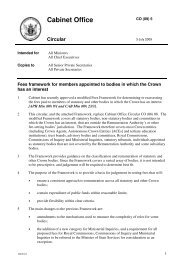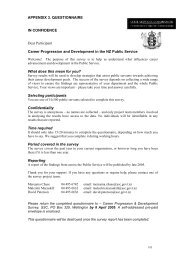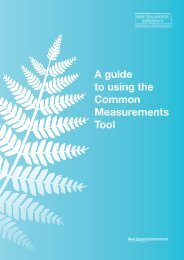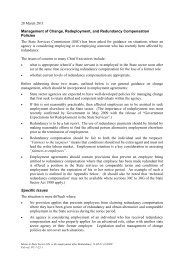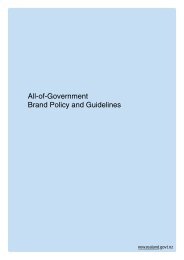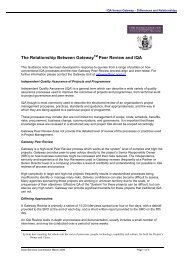NZ Report / Proposal Template - State Services Commission
NZ Report / Proposal Template - State Services Commission
NZ Report / Proposal Template - State Services Commission
You also want an ePaper? Increase the reach of your titles
YUMPU automatically turns print PDFs into web optimized ePapers that Google loves.
• the cost of construction in the hospitals and health categories increased by<br />
between 16.9% and 18.5%.<br />
4.16 However, the same advice noted that concrete supply and concrete products<br />
generally increased by only 4% - 8% and timber framing by 4% - 5%.<br />
4.17 In addition to increases in commodity prices, there were also significant increases<br />
in labour costs (which are another component of the CGPI-NRB).<br />
Labour Rates and Location<br />
4.18 Advice received from Peter Waterhouse (an independent construction cost<br />
consultant) provided evidence of increased labour rates:<br />
• rates for carpenters in Auckland region increased by up to 35%;<br />
• rates for concrete workers increased by up to 29%; and<br />
• rates for labourers increased by up to 25%.<br />
4.19 The remoteness of the Spring Hill and Otago sites also contributed to increased<br />
direct costs.<br />
• In the case of Otago, up to a third of the workforce at peak levels has had to be<br />
imported from outside of the coastal Otago region. This increased the level of<br />
travel and accommodation allowances.<br />
• Additional travel costs added the equivalent of approximately one hour per person<br />
per day to labour costs on the Spring Hill project.<br />
• We understand that the normal level of construction activity in the coastal Otago<br />
area is around $90 million per annum. Clearly, therefore, the Otago project<br />
represents a substantial increase over and above this figure. It is not too<br />
surprising, therefore, that the Otago project has put considerable upward pressure<br />
on costs.<br />
4.20 There is scope for some overlap and, hence, double counting across the various<br />
factors. In particular, the escalation factor measures increases in the costs of completing<br />
buildings. Implicit within the escalation is increases in labour rates, margins, overheads,<br />
materials costs and so on. In theory, therefore, the increases attributed to labour rates,<br />
margins and overheads (and possibly on-site construction costs) in the context of Spring<br />
Hill should be over and above the increases captured by the escalation. We are not<br />
convinced that this is strictly the case, but have no way of verifying it because of the lack<br />
of detailed workings.<br />
Margins and Overhead<br />
4.21 In addition to upward pressure on direct costs, there have also been increases in<br />
margins (which leads to a compounding effect when applied to increased direct costs).<br />
CMS reported to the Department 2 that:<br />
2 Assessment of Profit and Overheads margins for CWA Members dated 4 November 2005<br />
Key Drivers and Causes of Cost Escalation 18






